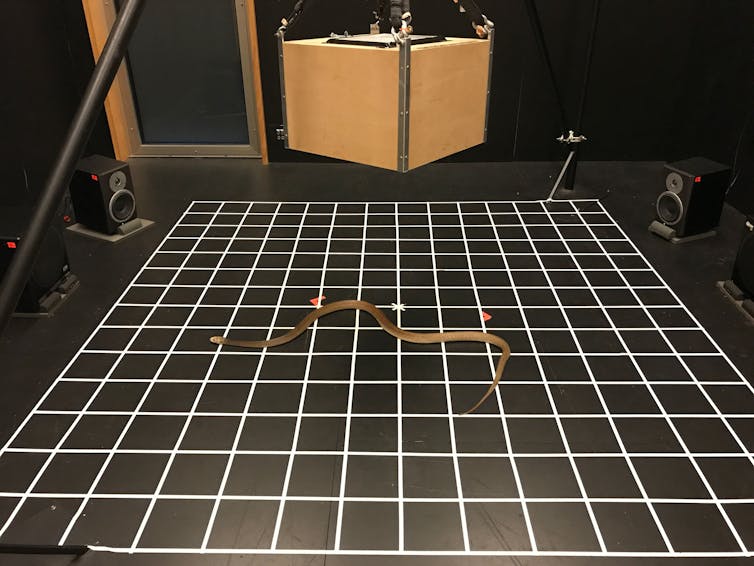Experts have long understood that snakes can feel sound vibrations through the ground — what we call “tactile” sensing — but we’ve puzzled over whether they can also hear airborne sound vibrations, and particularly over how they react to sounds. In a new paper published in PLOS ONE, we conclude snakes use hearing to help them interpret the world, and finally dispel the myth that they are deaf to airborne sound. Our research, which included 19 different snakes from seven species, reveals that not only do they have airborne hearing, but that different species react differently to what they hear.
How snakes respond to airborne and ground-borne sounds
Although seeing and tasting (the air) are the main ways snakes sense their environment, our study highlights that hearing still plays an important role in their sensory repertoire. This makes sense from an evolutionary perspective. Snakes are susceptible to predators, including monitor lizards, cats, dogs, and other snakes. Hearing is an important sense for both predator avoidance and injury avoidance (such as being trodden on).
For our experiments, we collaborated with the Queensland University of Technology’s School of Creative Practice to fit out a soundproof room and test one snake at a time. Using silence as our control, we played one of three sounds, each including a range of frequencies: 1-150Hz, 150-300Hz, and 300-450Hz. For comparison, the human voice range is about 100-250Hz, and birds chirp at about 8,000Hz.
In one previous study, researchers hung Western diamondback rattlesnakes (Crotalus atrox) in a steel mesh basket and observed their restricted behaviors in response to sound frequencies between 200Hz and 400Hz. In another, researchers surgically implanted electrodes into the brains of partially anesthetized snakes, detecting electrical potentials in response to sound up to 600Hz. But our research is the first to investigate how multiple snake species respond to sounds in a space where they can move freely. We also used an accelerometer to detect whether the sounds produced ground vibrations. In this way, we confirmed they were indeed registering airborne sounds, and not just feeling ground vibrations.
Do snakes move toward or away from sound?
Most of the snakes exhibited very different types of behaviors in sound trials compared to the control. Woma pythons (Aspidites ramsayi) — a non-venomous snake found throughout Australia’s arid interior — significantly increased their movement in response to sound and actually approached it. They exhibited an interesting behavior called “periscoping,” in which snakes raise the front third of their body in a manner that suggests curiosity.
In contrast, three other genera — Acanthophis (death adders), Oxyuranus (taipans), and Pseudonaja (brown snakes) — were more likely to move away from sound, signaling potential avoidance behavior. Death adders are ambush predators. They wait for their prey to come to them using the lure on their tail (which they wiggle to look like a worm), and they can’t travel quickly. So it makes sense they trended away from the sound. For them, survival means avoiding being trodden on by large vertebrates such as kangaroos, wombats, or humans.

Brown snakes and taipans are active foragers that rapidly pursue their prey during the day. This means they may be vulnerable to daytime predators such as raptors. In our experiments, both of these snakes appeared to have acute senses. Taipans in particular were likely to display defensive and cautious behaviors in response to sound.
Can snakes hear us?
Our study further debunks the myth that snakes are deaf. They can hear — just not as well as you or I can. They can only hear low frequencies, roughly below the 600Hz mark, whereas most of us can hear a much wider range. They probably hear muffled versions of what we do. So can snakes hear us? The frequency of the human voice is about 100-250Hz, depending on sex. The sounds we played in our trials included these frequencies, and were played at a distance of 1.2 m from them at 85 decibels. This is about the amplitude of a loud voice.
The snakes in our study responded to this sound, and many significantly so. So it’s probably safe to say they can hear people speaking loudly or screaming. That doesn’t mean they can’t hear someone talking (a normal conversation is about 60 decibels) — we just didn’t test sound at this noise level.
This article is republished from The Conversation under a Creative Commons license. Read the original article.
Christina N. Zdenek, Post-doctoral Research Fellow, Venom Evolution Lab, The University of Queensland
Follow us on Twitter, Facebook, or Pinterest



